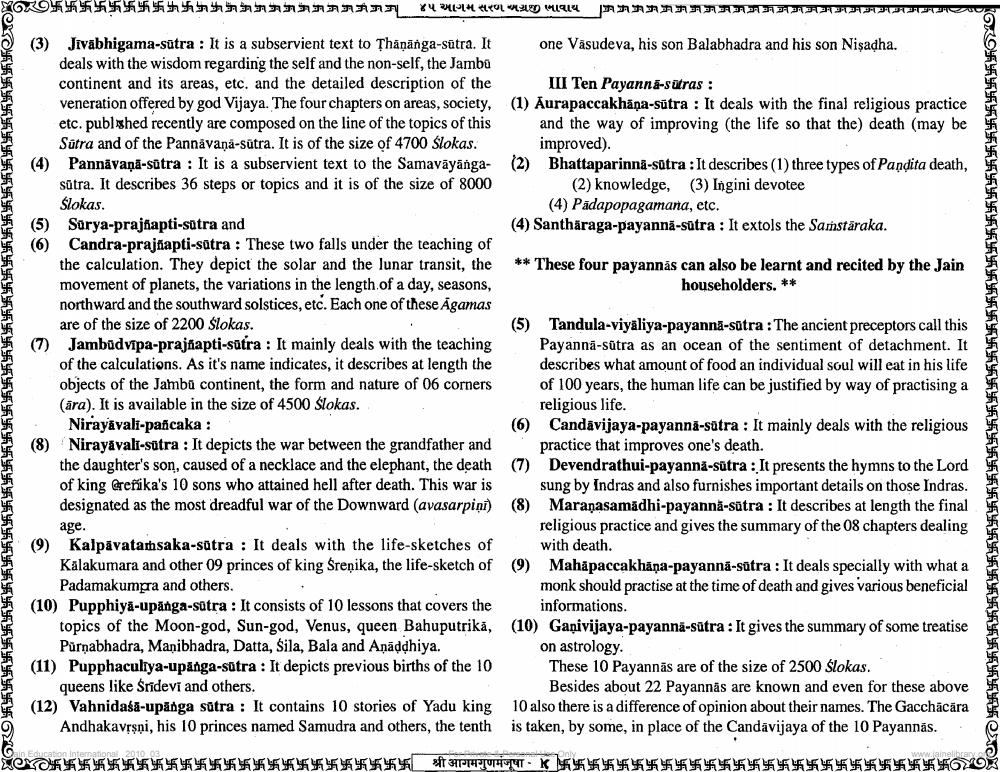________________
ShhhhĀMhMMMMMMMMMMMÁR ૪૫ આગમ સરળ અગ્રજી ખાવાથ
(3) Jivabhigama-sutra: It is a subservient text to Thaṇānga-sūtra. It deals with the wisdom regarding the self and the non-self, the Jambu continent and its areas, etc. and the detailed description of the veneration offered by god Vijaya. The four chapters on areas, society, etc. published recently are composed on the line of the topics of this Sūtra and of the Pannavaṇa-sutra. It is of the size of 4700 slokas. (4) Pannāvaṇā-sūtra : It is a subservient text to the Samavāyāngasūtra. It describes 36 steps or topics and it is of the size of 8000 Ślokas.
(5) Surya-prajñapti-sūtra and
(6) Candra-prajñapti-sutra: These two falls under the teaching of the calculation. They depict the solar and the lunar transit, the movement of planets, the variations in the length of a day, seasons, northward and the southward solstices, etc. Each one of these Agamas are of the size of 2200 Ślokas.
(7) Jambudvipa-prajñapti-sūtra: It mainly deals with the teaching of the calculations. As it's name indicates, it describes at length the objects of the Jambu continent, the form and nature of 06 corners (āra). It is available in the size of 4500 Slokas.
Nirayavali-pancaka:
(8) Nirayavali-sütra: It depicts the war between the grandfather and
the daughter's son, caused of a necklace and the elephant, the death of king @renika's 10 sons who attained hell after death. This war is designated as the most dreadful war of the Downward (avasarpiņi) age.
(9) Kalpavatamsaka-sutra: It deals with the life-sketches of Kalakumara and other 09 princes of king Śrenika, the life-sketch of Padamakumpra and others.
(10) Pupphiya-upanga-sutra: It consists of 10 lessons that covers the topics of the Moon-god, Sun-god, Venus, queen Bahuputrikă, Pūrṇabhadra, Manibhadra, Datta, Sila, Bala and Anaḍdhiya. (11) Pupphaculiya-upanga-sutra: It depicts previous births of the 10 queens like Sridevi and others.
(12) Vahnidaśā-upanga sutra: It contains 10 stories of Yadu king Andhakavṛṣṇi, his 10 princes named Samudra and others, the tenth Cain Education International 2010 03
JARNANAK
one Vasudeva, his son Balabhadra and his son Nişaḍha.
JARD
DA DA DA DA DAS
III Ten Payanna-sutras :
(1) Aurapaccakhāṇa-sūtra : It deals with the final religious practice and the way of improving (the life so that the) death (may be improved).
(2) Bhattaparinna-sūtra : It describes (1) three types of Pandita death, (2) knowledge, (3) Ingini devotee
(4) Padapopagamana, etc.
(4) Santharaga-payanna-sutra: It extols the Samstaraka.
** These four payannas can also be learnt and recited by the Jain householders. **
(5) Tandula-viyaliya-payanna-sūtra : The ancient preceptors call this Payanna-sutra as an ocean of the sentiment of detachment. It describes what amount of food an individual soul will eat in his life of 100 years, the human life can be justified by way of practising a religious life.
(6)
Candavijaya-payanna-sutra: It mainly deals with the religious practice that improves one's death.
(7) Devendrathui-payanna-sūtra : It presents the hymns to the Lord sung by Indras and also furnishes important details on those Indras. (8) Maraṇasamadhi-payanna-sūtra : It describes at length the final religious practice and gives the summary of the 08 chapters dealing with death.
(9) Mahāpaccakhāṇa-payanna-sūtra : It deals specially with what a monk should practise at the time of death and gives various beneficial informations.
(10) Gaṇivijaya-payanna-sutra: It gives the summary of some treatise on astrology.
These 10 Payannās are of the size of 2500 Ślokas.
Besides about 22 Payannās are known and even for these above 10 also there is a difference of opinion about their names. The Gacchācāra is taken, by some, in place of the Candavijaya of the 10 Payannās.
Only
« KAAKAKKKKKKKKKKKKKKKKKKKKKKOYOX
www.jainelibrary.o




